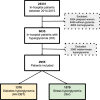In-Hospital Mortality and Glycemic Control in Patients with Hospital Hyperglycemia
- PMID: 34852895
- PMCID: PMC9380085
- DOI: 10.1900/RDS.2021.17.50
In-Hospital Mortality and Glycemic Control in Patients with Hospital Hyperglycemia
Abstract
BACKGROUND: Stress-induced hyperglycemia is a phenomenon that occurs typically in patients hospitalized for acute disease and resolves spontaneously after regression of the acute illness. However, it can also occur in diabetes patients, a fact that is sometimes overlooked. It is thus important to make a proper diabetes diagnosis if hospitalized patients with episodes of hyperglycemia with and without diabetes are studied. AIMS: To estimate the extent of the association between stress-induced hyperglycemia and in-hospital mortality in patients with hospital hyperglycemia (HH), and to explore potential differences between patients diagnosed with diabetes (HH-DBT) and those with stress-induced hyperglycemia (SH), but not diagnosed with diabetes. METHODS: A cohort of adults with hospital hyperglycemia admitted to a tertiary, university hospital in Buenos Aires, Argentina, was analyzed retrospectively. RESULTS: In the study, 2,955 patients were included and classified for analysis as 1,579 SH and 1,376 HH-DBT. Significant differences were observed in glycemic goal (35.53% SH versus 25.80% HH-DBT, p < 0.01), insulin use rate (26.66% SH versus 46.58% HH-DBT, p < 0.01), and severe hypoglycemia rate (1.32% SH versus 1.74% HH-DBT, p < 0.01). There were no differences in hypoglycemia rate (8.23% SH versus 10.53% HH-DBT) and hospital mortality. There was no increase in risk of mortality in the SH group adjusted for age, non-scheduled hospitalization, major surgical intervention, critical care, hypoglycemia, oncological disease, cardiovascular comorbidity, and prolonged hospitalization. CONCLUSIONS: In this study, we observed better glycemic control in patients with SH than in those with HH-DBT, and there was no difference in hospital mortality.
Conflict of interest statement
The authors declare that they do not have any conflict of interest associated with this article.
Figures
References
-
- Clement S, Braithwaite SS, Magee MF, Ahmann A, Smith EP, Schafer RG, Hirsch IB. Management of diabetes and hyperglycemia in hospitals. Diabetes Care 2004. 27(2):553-591. - PubMed
-
- Moghissi ES, Korytkowski MT, DiNardo M, Einhorn D, Hellman R, Hirsch IB, Inzucchi SE, Ismail-Beigi F, Kirkman MS, Umpierrez GE, et al. . American Association of Clinical Endocrinologists and American Diabetes Association consensus statement on inpatient glycemic control. Diabetes Care 2009. 32(6):1119-1131. - PMC - PubMed
-
- American Diabetes Association . 15. Diabetes care in the hospital: standards of medical care in diabetes 2019. Diabetes Care 2019. 42:173-181. - PubMed
-
- Umpierrez GE, Isaacs SD, Bazargan N, You X, Thaler LM, Kitabchi AE. Hyperglycemia: an independent marker of inhospital mortality in patients with undiagnosed diabetes. J Clin Endocrinol Metab 2002. 87(3):978-982. - PubMed
-
- Russo MP, Elizondo CM, Giunta DH, Grande Ratti MF. Prevalence of hyperglycemia and incidence of stress hyperglycemia in hospitalized patients: A retrospective cohort. Eur J Intern Med 2017. 43:e15-e17. - PubMed
MeSH terms
LinkOut - more resources
Full Text Sources
Medical

